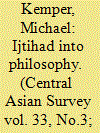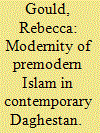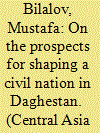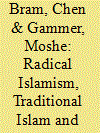|
|
|
Sort Order |
|
|
|
Items / Page
|
|
|
|
|
|
|
| Srl | Item |
| 1 |
ID:
065883


|
|
|
| 2 |
ID:
134375


|
|
|
|
|
| Summary/Abstract |
Starting in 1960, authors of various Daghestani nationalities initiated a re-evaluation of the role of Islam in the history of Daghestan. An important historical personality to draw upon was Muhammad al-Quduqi, a Daghestani Islamic legal scholar of the late seventeenth and early eighteenth centuries. Quduqi was known for his sympathies towards ijtihad (Islamic legal reasoning by analogy) and for his call to replace customary law by Islamic law. This article studies how Quduqi was brought back into Soviet discourse in 1960, and how his advocacy for ijtihad was subsequently interpreted in Marxist terms as a quest for philosophy, rationalism and progress, with secularizing terms drawn from the discourse of Daghestani Jadids of the 1920s and 1930s. A comparison is then made with Soviet Tatarstan, where Marxist historians constructed a similar autochthonous trajectory of Tatar-Islamic progress and enlightenment. In both cases, Islamic concepts were taken out of context and used for the construction of a secularized national Muslim cultural heritage (miras) that would prepare the ground for socialism – with the difference that in Daghestan, this Muslim Mirasism was multi-ethnic in character.
|
|
|
|
|
|
|
|
|
|
|
|
|
|
|
|
| 3 |
ID:
127577


|
|
|
|
|
| Publication |
2012.
|
| Summary/Abstract |
The Republic of Daghestan is the largest of the North Caucasian republics in terms of territory (50.3 thousand sq km) and population size (2.1 million). It borders on five states in the south of Russia: Azerbaijan and Georgia on land and Kazakhstan, Turkmenistan, and Iran across the Caspian. It has administrative borders with the Stavropol Territory, Kalmykia, and Chechnia. The incredible confessional and ethnic diversity of Daghestan is also a result of its very specific history and no less specific geographic location.
There are 2,451 religious units in the republic: 2,396 of them are Muslim; 50 Christian; and 5 Judaic. The Christian communities are Orthodox (19 in all), Old Believer (1), Armenian (2), and Protestant (28, 6 of which are Seventh Day Adventists; 5 are Pentecostals; 5 are Baptists of the Union of the Evangelical Baptist Christians of Russia; 5 are Baptists of the Council of the Churches of the Evangelical Christian Baptists of Russia; 1 is Good Tidings Evangelicals; and 6 are Jehovah's Witnesses). The majority of the republic's population are Muslims; the structural diversity of Islam, the predominant religion, is present in all spheres of social life.
|
|
|
|
|
|
|
|
|
|
|
|
|
|
|
|
| 4 |
ID:
105305


|
|
|
|
|
| Publication |
2011.
|
| Summary/Abstract |
This ethnographic essay investigates the relations between past and present forms of Islam in the north Caucasian Republic of Daghestan. Conversations culled from fieldwork in Daghestani urban and rural spaces are used to elucidate the cultural, religious, and linguistic diversity of life in this region. Ethnographies in a bookstore, a shrine to the Imam Shamil, and a scholarly archive in Makhachkala unfold against the historical background of Daghestan's long-standing encounter with the Arabo-Islamic world. The essay explores how the post-Soviet turn to post-secular Islam represents an alternative to colonialism and a new way of making meaning in the present. It is intended as a contribution to Islamic studies, modernity theory, and post-Soviet Union area studies.
|
|
|
|
|
|
|
|
|
|
|
|
|
|
|
|
| 5 |
ID:
118729


|
|
|
|
|
| Publication |
2012.
|
| Summary/Abstract |
Russia's integrity depends on ensuring civil identity as a priority factor in the development of society and the individual. Civil identity is fully realized in a civil nation that gradually takes shape within a particular society. The crisis of multiculturalism in the West triggered by the crisis of the European civilization and culture calls for a revision of certain ideas and theories associated with civil identity.
|
|
|
|
|
|
|
|
|
|
|
|
|
|
|
|
| 6 |
ID:
121473


|
|
|
|
|
| Publication |
2013.
|
| Summary/Abstract |
This study examines the interplay between Islam and collective identity and their position in potential conflicts by exploring the dynamics of Islam, ethno-nationalism and civic society within different parts of the Northern Caucasus. Historical and anthropological approaches are used for a comparative analysis of Daghestan and Chechnya in the east and of Kabardino-Balkaria and Karachai-Cherkesia in the west. The study demonstrates the importance of local context and historical background to the understanding of ethnicity, nationalism, civic identity and their interplay with Islam. The analysis highlights that the different history and socio-cultural characteristics of the different regions in question leads to different approaches to religion which contain a paradox. In Daghestan and Chechnya, Islam is well established and the authorities have to collaborate with different Islamic bodies in their struggle against 'Wahhabism'. In Kabardino-Balkaria and Karachai-Cherkesia the 'legitimate' Islamic leaders - whether those representing the state or leaders of other Islamic movements - are powerless. While this represents the overall weak position of Islam in these areas, paradoxically it also opens options for radical Islamists to gain support, in the context of economic hardships, weakening of other sources of identification, and corruption. This process is generated and fostered by policies that limit ethno-nationalism and expand the struggle against radicalism to a struggle against religious activity in general. The Northern Caucasus has often been perceived as a major locus of radical Islam, and as a strategic rift in the 'clash of civilizations'. This study claims that the significant rifts and conflicts are between different Islamic alternatives. Important variables crucial to this discussion highlighted by the case of the Northern Caucasus are ethnicity, nationalism, civic identity and their interplay with Islam. At the same time, this case also highlights that the potential of radicalism in Islamic societies is not the mere result of its own 'characteristics', but is also a product of policy towards Islamic societies by outside actors, in this case Russia.
|
|
|
|
|
|
|
|
|
|
|
|
|
|
|
|
| 7 |
ID:
078089


|
|
|
|
|
|
|
|